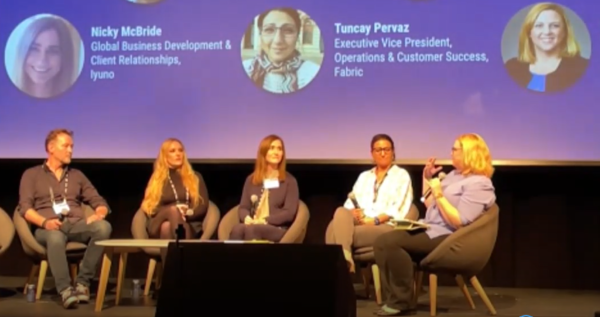M+E Daily

British HITS Panel: Why the Cloud Localisation Blueprint Matters
Story Highlights
Launched during IBC’s Accelerator Program in September and involving more than 10 companies across the localisation supply chain, the Cloud Localisation Blueprint (“The CLB”) pioneered a streamlined, cloud-based workflow approach to increase efficiencies and transparency among participants.
Often described as “spaghetti-like,” the process of content localisation lacks visibility and, with the vast number of vendors, studios and service providers involved, it is ripe for innovation, transformation and disruption.
The CLB is seen by industry experts as the catalyst for changing how partners engage and interact along this chain with the help of automation and transparency.
A panel of industry experts discussed the significance of The CLB during the panel session “What is the Cloud Localisation Blueprint (and Why does it Matter?)” at the Nov. 15 British Hollywood Innovation & Transformation Summit (HITS) event in London
Introducing the panelists, moderator Hollie Choi, managing director of the Entertainment Identifier Registry (EIDR), noted they were a “small contingent of the folks that worked with us on this cloud localisation blueprint.” EIDR, she pointed out, is providing the interoperability layer for the blueprint.
“For me, The Cloud Localisation Blueprint project was a modern approach to a localisation workflow that automates the process and allows visibility into the process all the way through,” she explained. “There’s sort of these really cool components and these great, best in class vendors and products that were involved in making this all possible.”
There is something along the lines of a “working prototype” already, she said, but conceded: “I don’t know if everybody else would agree with that.” However, she added: “We know that it does work…. We did approve a concept. It actually is functional.”
 WarnerBros. Discovery has “been sort of on this journey, more formally of late, but I guess even before this, kind of working with these folks,” noted James Crossland, that company’s SVP and head of global content operations.
WarnerBros. Discovery has “been sort of on this journey, more formally of late, but I guess even before this, kind of working with these folks,” noted James Crossland, that company’s SVP and head of global content operations.
“For us, bringing alive the kind of data that drives your supply chain, and particularly when we think about localisation, the ability to plan is a huge issue for anyone who works in our business,” he explained.
“We all know there’s capacity challenges in markets and the ability to plan as far ahead as possible,” he said, noting: “We talked about EIDR and we also use EIDR as part of this, which is great because [it is] one thing planning further ahead, but [also important is] understanding what are we planning and what is the identifier for that thing we’re planning?”
He added: “Particularly interesting for us, when it comes to re-versioning and bringing things back from our libraries, how do we know it’s the same thing that we had five years ago?”
Then “there is the cloud aspect” of the blueprint, which he said has “really been the game changer.” He explained: “A lot of these processes used to be running on-prem infrastructure and/or running on spreadsheets, quite frankly, and bringing all this stuff together so data sits in one place” is important.
He went on to say: “Applications are usually accessible. We don’t have to go to our IT departments and ask them to go and deploy things on servers. We can actually use stuff in the cloud. So that really made it sort of really more accessible to our teams. And then the sort of icing on the cake for us really was that interaction between us and our partners and our vendors, because they’re all subscribing to the cloud and it makes integration a heck of a lot easier.”
An Inherent Challenge
Warner has “better visibility than we used to” now, he continued. “Part of the challenge I think this blueprint does go a long way to address is that you’ve got a very human process at the core of this, no matter what we do. So there is lots of opportunity for automation, lots of opportunity to use data. But, at the end of the day … dubbing and subtitling [still have] humans at the core of it.”
With that, he said, “comes deadliness that shift [and] that becomes capacity challenges.”
However, “those are always going to be there, quite honestly,” he said. “But what it does do for us is help plan those things further ahead and get more visibility into where there’s going to be risks and issues. And the key thing is …. last year, we had a day and date strategy without theatrical content.”
Having “visibility far enough ahead of time to know if we need to pivot” is crucial, he added. “You can pivot a day and date show several months in advance, depending obviously if there’s not a big theatrical title. You can’t pivot two weeks in advance. That’s kind of a no-no. So it really helps us [be assured] that everything that we need to be there, including all the dubs and subs, is going to be there.”
Helping to Figure Out What Customers Want
Codemill specialises in UX design and full stack custom software development for media asset management and the content supply chain for the media and entertainment industry.
“We kind of come at the end of the supply chain,” noted Lucia Johnstone-Cowan, senior sales manager at the company.
“What the blueprint has really done for us is made us think, ‘OK. What do users really want from the products? What do they need?’ And it’s really switching our focus really from just sort of thinking more about processes and then actually, in a weird way, putting people into the focus and thinking, ‘what do they need from our tools? How can we make their day to day a lot better?’”
‘Like Herding Cats?’
A few people asked if the The Cloud Localisation Blueprint was “like herding cats,” noted Tuncay Pervaz, EVP, operations and customer success at Fabric, whose cloud platform allows customers to manage editorial, technical and other metadata about games, movies, TV shows and other video content.
But “it wasn’t actually as difficult as I thought it would be,” she said.
The “initial pitch” for the project was “actually around kind of streamlining the localisation process with a unified data architecture,” she recalled. “That pitch was successful. However, as we pitched it and approached other companies and the other tech partners heard about it, they wanted to be involved. So everyone wanted to be involved, which allowed us to really expand the ambition and the engagement of what we were trying to do.”
She added: “As with anything, when you’re trying to solve a problem, the first thing we did was define the problem. And, during that stage, it was evident that although each company, each content creator had their own unique set of problems throughout the localisation supply chain, the overarching problems that we wanted to solve were actually like the same.”
What happened, therefore, was all the participants in the project “had a common cause everyone was working towards,” she said. They “whittled it down to [the issues of] the capacity, the visibility, the infrastructure … and the universal standards.”
Humans Still Key
Agreeing with Crossland, Nicky McBride, global business development and client relationships at media localisation provider Iyuno, said “80 percent of what we do is still basically human beings in a studio acting and translating and performing work.”
What’s more, until artificial intelligence takes on a more significant role, “we still have to schedule those human beings to be in that room at a certain time to perform that role and deliver materials back,” she pointed out.
Therefore, she added: “We only have a small percentage of our internal workflow to play with and to look for opportunities for more efficiency, for better quality, for quicker turnaround, for managing our capacity better. And that’s why this was really a great opportunity for us.”
The British Hollywood Innovation & Transformation Summit, held in conjunction with the EIDR Annual Participant Meeting, was sponsored by Whip Media, GeoComply, Perforce, Signiant, and EIDR, was programmed under the guidance of the content advisors of the Hollywood IT Society, and was produced by MESA and the Hollywood IT Society (HITS).









